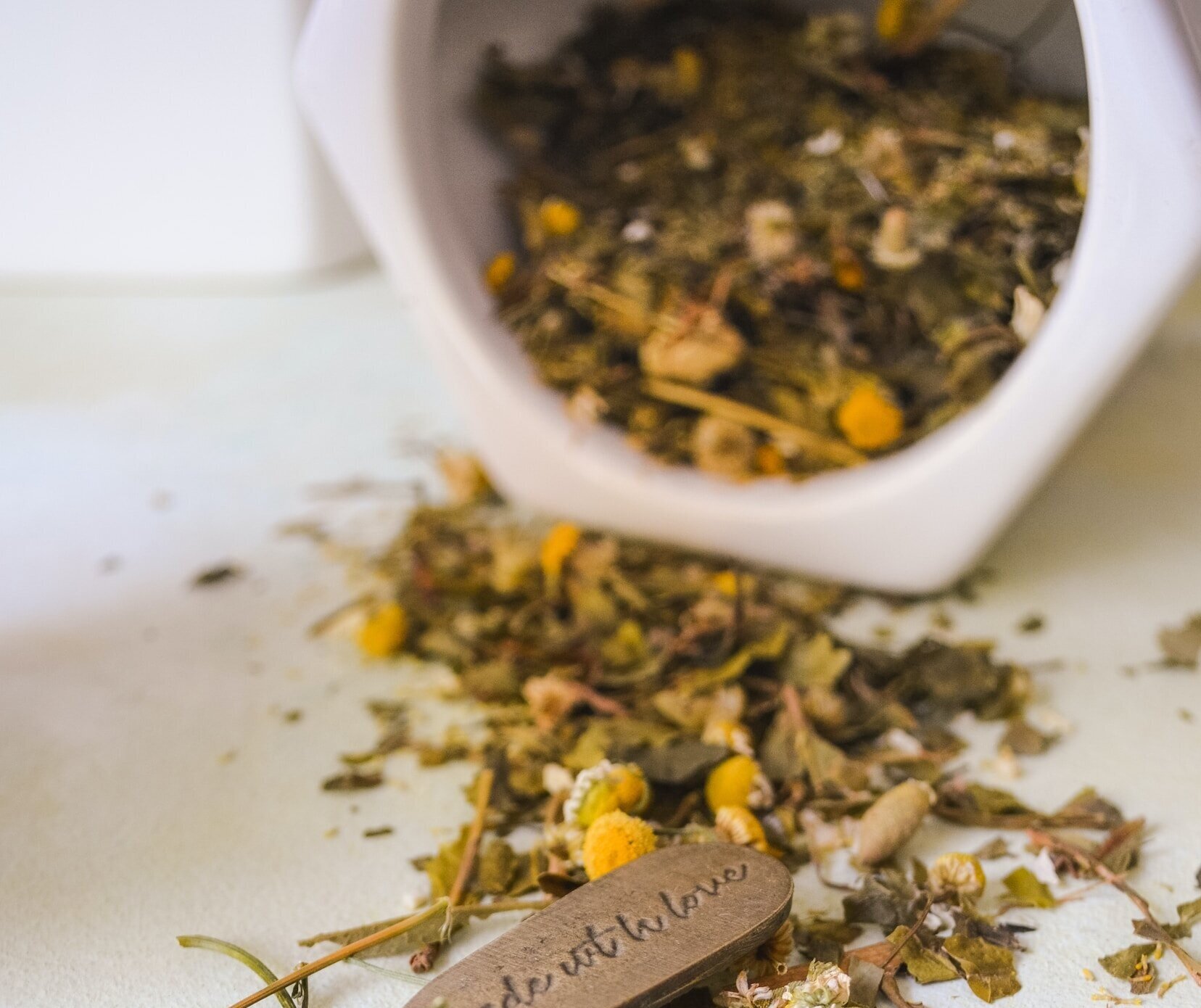Chamomile: An Herbal Guide to this Amazing Plant
What is Chamomile?
Chamomile is one of the most globally recognized herbs, known for its ability to rest and digest. It is instantly soothing and supports digestion by being a mild bitter and antispasmodic.
It is supreme for calming the nervous system and helps with sleep. It’s good for nervous tension, especially with children, pets or those who complain a lot. As Matthew Wood notes in The Book of Herbal Wisdom, this is a great herb for heat and tension when there is tenderness and a feeling of being incomplete, even such as an incomplete fever (Wood, Matthew. The Book of Herbal Wisdom. Pg 203.)
It can support a number of inflammatory skin conditions from acne to poison ivy, rashes, sunburns and general irritations, making it a nice topical oil. Its antimicrobial actions are also beneficial as a mouthwash for ulcers or wounds within the oral cavity.
Chamomile’s bitterness helps stimulate the production of bile. It’s a great digestive herb for reducing spasms. In a 2006 clinical study of children with acute diarrhea, it was shown to significantly reduce symptoms.
Herbal Monograph Profile: info on Chamomile
An herbal monograph is a complete profile of a plant: covering the plant’s botany, herbal energetics, how it has been traditionally used for health benefits and modernly used. It also reviews potential safety considerations.
See below for my herbal monograph profile on Chamomile, to discover key benefits and learnings.*
Scientific Name: Matricaria chamomilla
Family: Asteraceae
Common Name: Chamomile
Parts Used and Collection: Flower
Habitat and Cultivation: Asia, Europe
Taste: Bitter
Energetics: Cooling and drying
Health Actions: Anti-inflammatory, antimicrobial, antispasmodic, carminative, nervine, anti-diarrheal, sedative
Chamomile (Matricaria chamomilla)
A botanical drawing of the chamomile plant.
Chamomile Traditional Uses
A very cool fact about Chamomile is that it was discovered in the scrapings from a Neanderthal’s teeth dating over 50,000 years ago (Barras, Colin. Neanderthal’s dental tartar reveals evidence of medicine).
In Traditional Chinese Medicine (TCM), it is used for constricted liver chi or “liver attacking the stomach”.
Samuel Hahnemann, the founder of homeopathy, hilariously says it can relieve “morbid symptoms produced by the excessive use of coffee and narcotic symptoms” (Wood, Matthew. The Book of Herbal Wisdom. Pg 204). If you’re on that coffee grind maybe chamomile is a good answer.
Chamomile Health Benefits & Modern Uses
Digestive Health
Anti-inflammatory Properties: Chamomile contains anti-oxidant and anti-inflammatory compounds like quercetin that may reduce pain, help soothe the digestive tract and alleviate symptoms of indigestion or bloating.*
Inhibits H. Pylori and Smoothes muscle tissues: Preclinical models show that Chamomile may inhibit H. Pylori, a bacteria that is higher in IBS and IBD and can contribute to ulcers and inflammation.
Skin Health
Chamomile has been traditionally used for skin conditions like rashes, sunburn, skin irritations and bumps.
It is popular in hair care and aromatherpay. In this PubMed article, they share that “ Roman chamomile is widely used in cosmetic preparations and in soothing and softening effect on the skin.”
Eczema Relief: Topical application of chamomile extracts may help soothe irritated skin, making it potentially beneficial for conditions like eczema.*
Sleep Health
Calming and Sedative Effects: Chamomile is often used for its mild sedative properties, which may promote relaxation and help improve sleep quality. In this research article, it shares that Chamomile’s flavonoid apigenin, that binds to gamma amino butyric acid (GABA) receptors in the brain which helps get the body into a state of sleep and relaxation (Avallone R, Zanoli P, Corsi L, Cannazza G, Baraldi M. Benzodiazepine compounds and GABA in flower heads of matricaria chamomilla. Phytotherapy Res. 1996;10:177–179).
Nervous System Health
Stress Reduction: Chamomile has been traditionally used to alleviate stress and contribute to an overall improvement in mood and mental well-being. Most folks who drink chamomile notice an instant up-lifting effect. It is also useful for crying children of people who complain a lot.
The chamomile flower essence is noted for helping bring about a state of a serene emotional balance. It is used where someone can be easily upset or sensitive, moody, and having tension, It is a plant that is used to focus on the solar plexus.
Chamomile: How to Use it, Science and Safety
How to use Chamomile:
Chamomile can be nice as a:
herbal infusion or hot tea
culinary uses in cooking and baking
syrup
powder
capsule
essential oil
flower essence
topically infused oil
tincture
An easy way to make it is by using about 2-3 teaspoons 8oz of hot water, cover and steeping it for 7-10 minutes.
Common Herbal Combinations:
These herbs can pair nicely with Chamomile
Mint (Mentha spp)
Turmeric (Curcuma longa)
Ginger (Zingiber)
Safety and Contraindications:
Chamomile is generally recognized as safe GRAS, it’s even used for pets like cats and dogs. Though folks with sunflower or daisy allergies may want to avoid since it’s a member of the Asteraceae sensitivity
Pregnancy and Lactation: Generally recognized as safe in pregnancy and lactation. Always consult with a doctor.
Creating a Connection with Chamomile
Curious about chamomile? Feel free to leave a comment below or reach out to me directly! And remember, it’s always good to consider if an herb is right for you.
*These statements have not been evaluated by the Food and Drug Administration. The information above is purely educational and cannot substitute professional medical advice. It is not intended to treat, cure, or diagnose medical conditions. Consult with a medical professional if you have any concerns.


